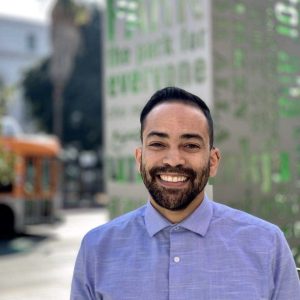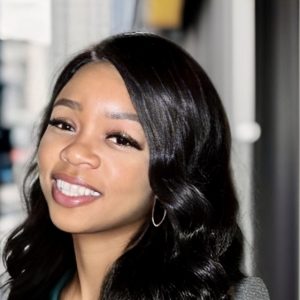Black in the American Institute of Certified Planners (AICP)

Jason Patrick Douglas, AICP
My path to an American Institute of Certified Planners (AICP) certification was a significant milestone in my career. My AICP certification is a validation of my education and experiences and brings a layer of legitimacy and integrity to my work and our work through the Black Planners of Los Angeles (BPLA). As I reflect on this moment, I am struck by the duality of this accomplishment as I work in a profession firmly rooted in the institutionalization of racism and inequity. This certification weighs heavy on me, as much of my career is focused on redressing the harm of planning practice in underrepresented communities and guiding communities through a process of healing and restitution.
The foundation of modern American planning practice is often drawn back to the late 1800’s, in the shadow of the U.S. Supreme Court (1896) decision to uphold state-mandated segregation laws that limited access and opportunities to Black communities across the country. At the height of segregation, the planning profession came into its own as successive comprehensive plans and zoning ordinances were adopted and infrastructure investments were made at the expense of low-income communities of color. This is the profession’s original sin – it came into its own by codifying the experiences of white communities and shaping the built environment in their image.
In preparing for the AICP exam, I attempted to mentally conjure up old college lectures and reacquainted myself with the contributions of popular movements in our profession such as the Garden City, the City Beautiful, and New Urbanism. Yet, these studies largely gloss over how these defining schools of thought and planning milestones like Central Park to Robert Moses’ Southern State Parkway came at the expense of thriving communities of color.
It became clear that “BIPOC Urbanism” exists in spite of the mainstream white, male perspectives that are promulgated through planning’s academic canon. We founded BPLA on this principle – to confront the racist legacy of urban planning in the United States, and to elevate voices and legitimize experiences of Black communities.
The concept of Black urbanism, in particular, is not without precedent in America’s urban history, yet these thriving communities were frequently met with racialized violence from Greenwood District in Tulsa (1921) to Cobbs Creek in Philadelphia (1985). It is our responsibility as planners to remember our history and culture and to ensure that Black excellence is a part of the planning canon.
As we study Robert Geddes and Lewis Mumford, let’s remember lessons taught by Black urbanists like W.E.B. Du Bois in “The Philadelphia Negro” (1899) and Horace Cayton Jr in “Black Metropolis: A Study of Negro Life in a Northern City” (1962).
As we laud pioneers like Jane Addams, Jacob Riis, and Lawrence Veiller; let’s remember Ida B. Wells and her work to house Black students and workers in Chicago through the Negro Fellowship League.
As we elevate the ubiquitous works of Bernice Abbott or Dorothea Lange, we must also celebrate the contributions of fellow photojournalist, Gordon Parks, who brought to mainstream consciousness the conditions of America’s Black communities. Let’s also listen to the anecdotes of writer and activist James Baldwin who documented the Black experience and confronted racist practices in urban America.
As allies and advocates like Paul Davidoff, Norm Krumholz, and Sherry Arnstein cultivated the modern practice of “advocacy planning” during the peak of the Civil Rights era in the 1960’s, let’s also honor Black community leaders like Dorothy Mae Richardson who led a movement in Pittsburgh for resident-led, place-based community development.
As we all level up in our own careers, whether it is through AICP or promotional opportunities, we must ensure that planning happens for BIPOC communities, not to them. As members of BPLA, we carry on the responsibility to the profession to ensure that the history and culture of our communities are celebrated and honored. As members of AICP, we have the unique opportunity to shape the future of our profession and bring a perspective that has long been left out of the planning canon – ours.
2024 APA National Planning Conference (NPC) Recap

Angela Williams
Attending the 2024 APA National Planning Conference (NPC) in Minneapolis, Minnesota, was an enriching experience that exceeded all my expectations. The conference was packed with insightful sessions, cutting-edge presentations, and invaluable networking opportunities with leaders and peers from across the planning profession. One of the most impactful and personally meaningful aspects of the conference was witnessing the significant representation of people of color among the attendees. The diverse presence of planners created a vibrant and inclusive atmosphere, fostering a profound sense of belonging within the planning profession.
Seeing so many planners of color gathered in one space was incredibly empowering. It underscored the importance of our voices and perspectives in shaping the future of our communities. The representation at NPC affirmed that diversity is not just encouraged but essential to the success and relevance of urban planning. This experience highlighted how critical it is for professionals from diverse backgrounds to be involved in these discussions and decision-making processes.
Overall, attending NPC 2024 was an immensely rewarding experience, filled with excellent speaker panels, networking sessions, and interactive workshops. For the first time at a conference, I didn’t feel lost in the crowd. I had the opportunity to join a Black Planners chat group on WhatsApp, which kept me informed about the day’s popular sessions and post- conference meetups. This connection allowed me to foster meaningful business relationships and find a safe space among peers to connect and recharge. The sense of community and belonging I felt was profound, highlighting the importance of diversity and representation in our profession.
I strongly encourage members of the Black Planners of Los Angeles (BPLA) to attend future APA conferences. Your participation is crucial, not only for your professional growth but also to ensure that other first-time attendees can experience the same sense of inclusion and community that I did. By attending, you can contribute to a more diverse and equitable planning profession and help inspire others to see themselves as vital contributors to the planning field. Let’s continue to build on this momentum and ensure that our collective commitment to equitable and inclusive planning practices remains strong.
Conference Takeaways: Plan your schedule prior to arrival, Participate in a range of topic sessions, Network with a purpose, and Explore the city. By far, the most memorable aspect of the conference was exploring the downtown Minneapolis Skyway System (so cool!).